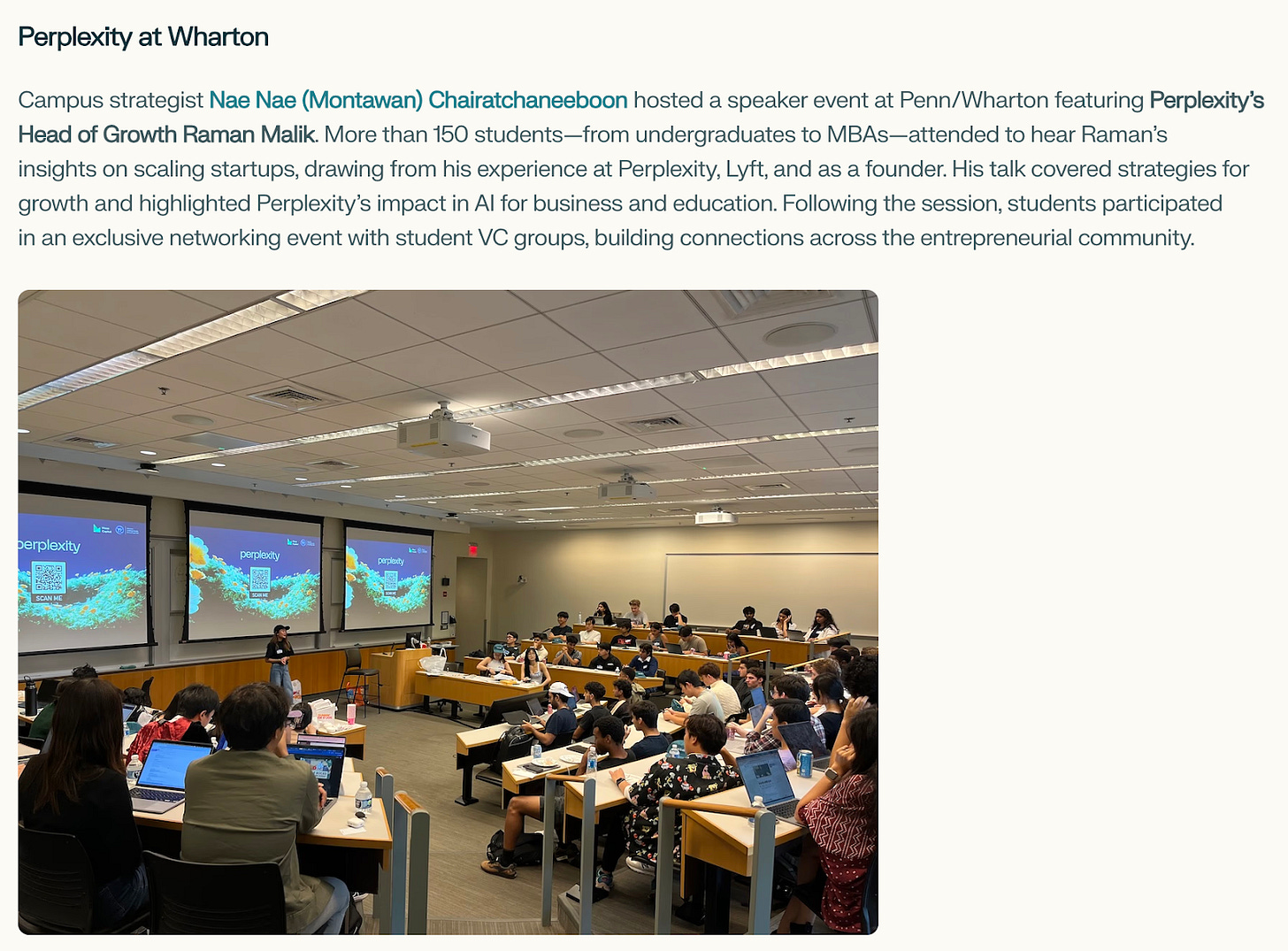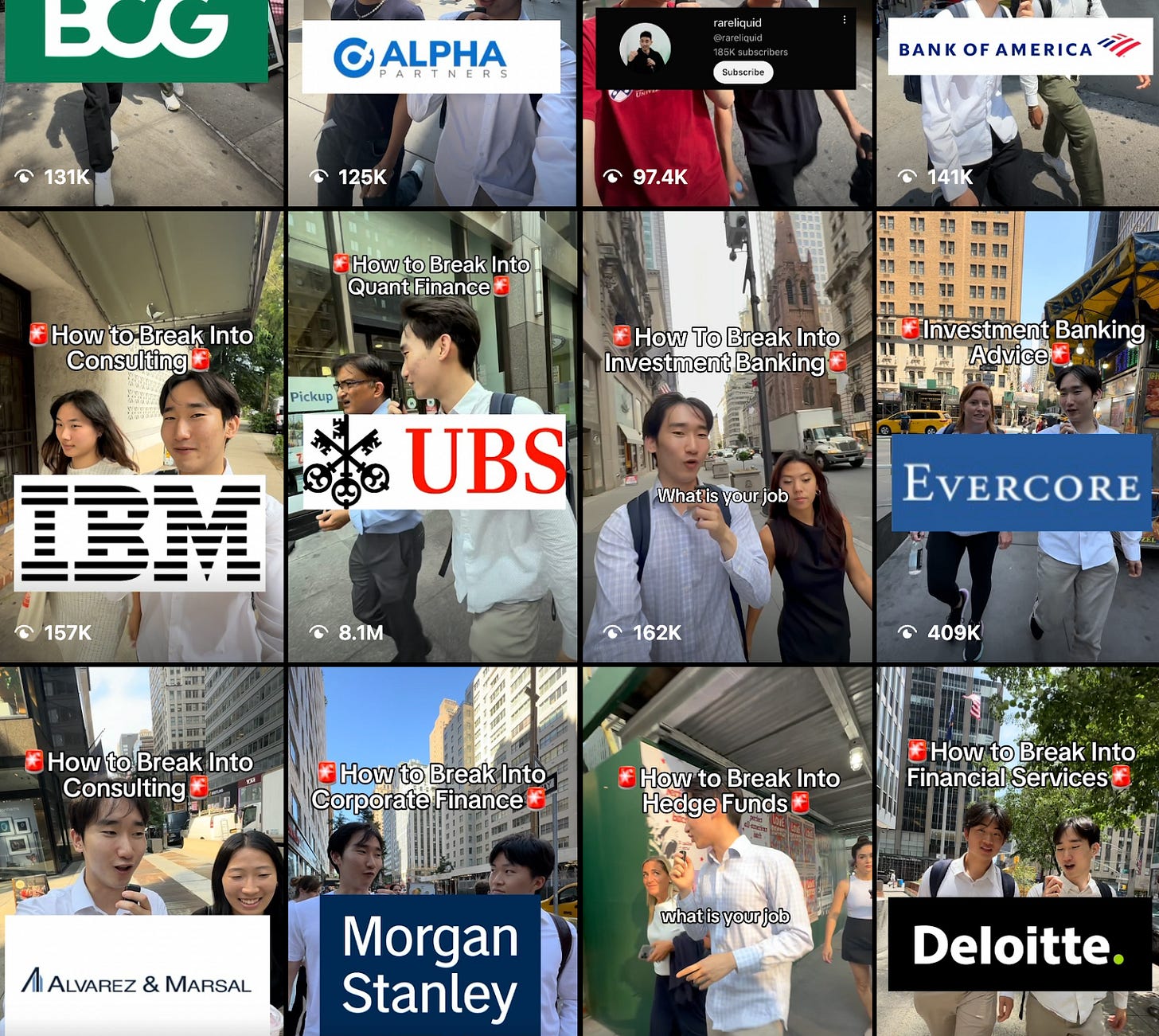Last Updated: 12/23/24 - I will update this playbook as I come across new strategies.
I spend a lot of time thinking about growth for consumer apps (partly because this is what I get paid to do). This article will detail a list of growth strategies that consumer apps use to grow their business. And reminder, this is not meant to be an in-depth playbook! I focused primarily on strategies that I’ve come across that I believe have returned positive ROI.
I will structure this piece by articulating a specific growth hack and dive deep into individual case studies from businesses that have been successful at it. Let’s dig in!
Campus Ambassadors
If you’re a consumer app, targeting college-aged students, then you have to be running an ambassador program. Leading consumer social, dating, and AI apps are all using ambassadors as a way to grow, and the reason is because people want to use what their friends are using.
Usually, a startup would hire a couple ambassadors at a college, and have their ambassadors run campaigns to grow the app. These businesses will usually pay these ambassadors a stipend on a weekly or monthly basis. Here are some examples:
Fizz
Fizz are is an anonymous social media posting platform on college campuses. Fizz’s Ambassadors, including a friend of mine, started popping on Penn’s campus last year. They slid small paper slips in college buildings (under the door, on tables) explaining what Fizz was. Fizz also set up tables on our college campus to get users to sign up. From what I was told, they also worked with clubs, paying the club for each member that signed up.
Perplexity
Perplexity is the next “Google with AI” as I like to put it. They’re rapidly gaining marketshare, with a possibility of disrupting the Google search monopoly. Perplexity started their Campus Strategist program earlier this fall, and seems to have been a huge hit. They’re renewing their program for next semester (and going international), evidence that there’s a positive ROI.
For Perplexity, they hired dozens of Campus Strategists per campus, each tasked with “running a campaign.” They were given guidelines of example campaigns, but they were tasked to creatively think through campaigns that would result in the most activations. Strategists would submit a proposal and the Perplexity would either accept or reject their proposal. Perplexity, of course, would provide the necessary resources (merch, money, etc) to ensure the campaign to be successful.
Here’s an example of a previous campaign ran by one of my good friends at Penn!
Partiful
Partiful is another example of a consumer social app that grew through an ambassador program. They haven’t released their ambassador program for the Spring 2025 semester, so I’m unsure what their ROI is. Similar to other ambassador programs though, they “paid” their ambassadors to party. They provided a $100 stipend to their ambassadors every month. By throwing parties using Partiful as the RSVP platform, they were able to get users to engage and sign up.
See an example of an RSVP:
Creator Ambassadors / UGC
These have been the new go-to growth channel for startups, especially for these new consumer AI study tools. Companies will basically hire a bunch of content creators (usually with less than 20k followers on their main account), and have them post 3-20 times a week promoting their products. These videos will be posted on a separate dedicated account, and creators will be paid on a per-post basis. This is attractive to these creators as 1) they get paid, and 2) they get to build up a portfolio of making UGC (user-generated content). This is attractive to startups because they can often pay these creators at a discount to their influencer peers. This strategy in particular is extremely popular and we’re seeing businesses constantly poach creators from eachother.
AirbudsWidgets
Airbuds Widget is a social music app that allows friends to share their listening activity in real-time. Airbuds has taken content creation to a whole new level by hiring dozens of students and everyday creators to run brand-new TikTok accounts. There were over 50 active accounts dedicated to this strategy. These creators typically post 2 to 4 videos daily, with some pushing out up to 10 videos a day.
Here’s what’s fascinating: the top-performing accounts see up to 17% of their videos achieving 10x the median performance, with 8% going completely viral. On the other hand, the worst-performing accounts don’t hit viral status at all.
But here’s the kicker—it doesn’t matter. Airbuds has engineered virality through sheer volume and consistent lo-fi content creation. On their worst days, they’re still pulling in at least 5 to 10 videos with over 100k views organically. Every. Single. Day.
This is a prime example of how relentless content production can create consistent exposure and results, even when individual posts don’t perform exceptionally well. It’s a strategy worth noting for consumer-facing brands looking to make waves on social media.
AI Study Tools
And it appears that every single AI study tool on the face of this earth is also deploying this growth hack. A lot of creators are creating “face-less” content in order to go viral. See an example below with 11M views. These “organic” videos can easily lead to 20% growth for a business if it’s hit above 1M views. With enough swings, one video is bound to land, growing the business tremendously.
Connecting Brand to a Face
We’re seeing a lot of brands building brand equity by connecting the brand with a public figure. Think of them as being the “face” of the brand — people associate the brand with that particular face. This again is posted on social media, so it hinges on the videos going viral for it to have a meaningful impact on new users. However, I believe that this is the best way to build a “moat” around a social media strategy.
A lot of these strategies previously listed are easily replicable — campus ambassadors or creator ambassadors. However, what’s hard to replicate is the brand that you’ve built and it’s even harder to replicate if the brand is built on an individual’s face. This is the “defensible moat” that every brand needs to build on social media in order to survive. This isn’t to say that there aren’t downsides. For example, if a brand is built on a face, then the business will need to pay an extremely high price in order to keep the face of the brand. If the face leaves, then the brand dies. I’ve seen this happen with a multitude of companies where they’re forced to increase the salary of their “face” to prevent them from bouncing.
Duolingo
I can’t think of a better example than the Duolingo bird. Duolingo’s green owl, Duo, has become inseparable from the brand’s identity, thanks to its outrageous and humorous antics on TikTok. Managed by 23-year-old Zaria Parvez, Duo’s “unhinged” content includes everything from twerking on desks to hilariously threatening users to keep up with their language practice. This bold approach humanizes the brand and has helped Duolingo reach viral fame, landing its content in media outlets and on millions of TikTok users’ feeds. Duo’s relatability and comedic timing make it a standout mascot in the crowded app landscape.
What’s more, Duo’s TikTok stardom is driving results. By hopping on trending sounds and actively engaging in the comment sections, the mascot keeps audiences entertained and invested. Since Duo’s TikTok persona became a staple of Duolingo’s content strategy, the app has seen a surge in users discovering it through the platform. This strategy proves that a playful, larger-than-life mascot can do wonders in turning casual viewers into brand enthusiasts, solidifying Duo as a cultural icon for the app.
See below for an example of how Duolingo engages with users on social media:
BeReal
Another great example is BeReal! I first heard about BeReal on social media when I saw this European dude — David Aligas — make videos about the app. I saw him over and over again that I thought that he was the founder of the app — that’s when you know the marketing was great. The authenticity that he brought on the BeReal TikTok was enough to convince me and millions of other people to download the app. However, the problem that I listed initially will come to haunt BeReal. After BeReal was sold, David ultimately left the company. As you can imagine, this negatively impacted the company and their new users and views have fallen drastically.
David ultimately left for Hoppy, a new dating app. On the Hoppy instagram, David is using the exact strategy that he used with BeReal to grow the app. It’s still early to guess how this app will perform, but I wouldn’t be surprised to see it flourish (I’m quite bullish on it)! Fun fact, they’re also deploying a campus ambassador strategy.
RecruitU
This is one of my friends' startups. RecruitU helps college students land finance and consulting internships. Daniel Min runs the account and started doing street interviews to build an online presence. Daniel, himself, is also a content creator. Therefore, similar to David, they’re using their personal audience to first juice the account to gain initial traction. He’s now infamous for doing these street interviews, and the account just wouldn’t be the same if it wasn’t Daniel creating these videos.
Other Growth Initiatives
Having a Great Product
Oftentimes, we want to engineer growth. However, engineering growth doesn’t matter if you have a terrible product. You might hack growth, but these users will just leave the next day. That said, a business must inherently have a great product to succeed. A great product will often lead to organic growth through word of mouth marketing, which is the strongest marketing strategy for any business. This is partly my hypothesis on why campus ambassadors work so well — if your friends are promoting a product, you’re just more likely to use it.
Influencer Marketing
This is one of the more classic ways of growing a consumer business. However, I’d argue that influencer marketing is slowly dying, especially for startups who might not have the funds for it. From my experience, we’ve received a greater return investing in nano/micro-influencers with 10-20k followers than influencers with hundreds of thousands of followers. Startups should target niche influencers with a specific audience (let’s say college content creators for an AI study tool) rather than a celebrity with a million followers.
That’s wraps! I will occasionally update this as I come across more growth strategies :)









